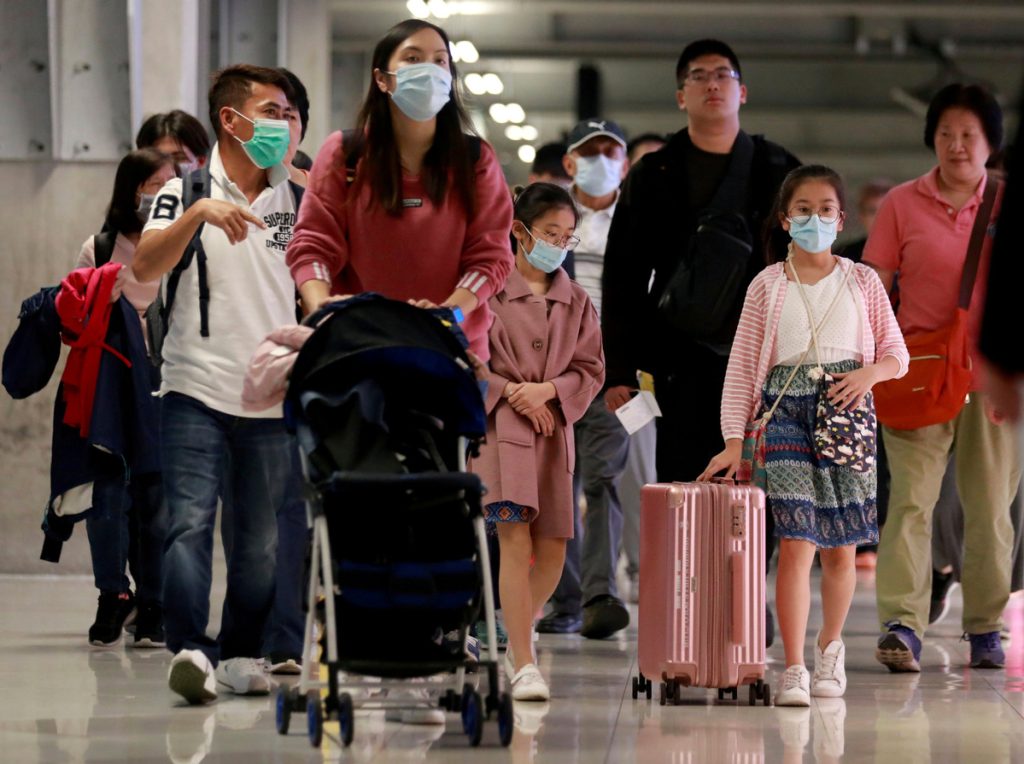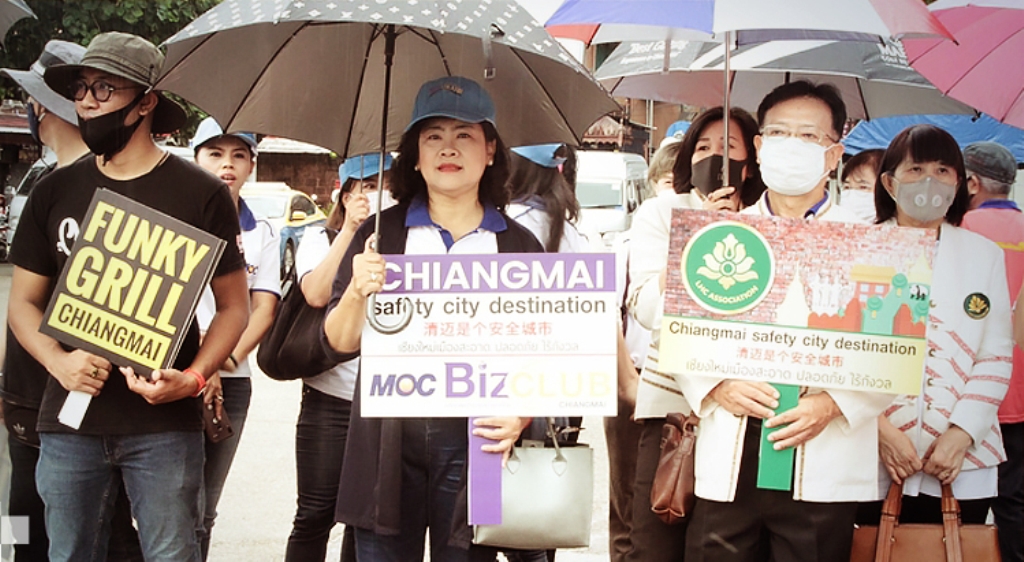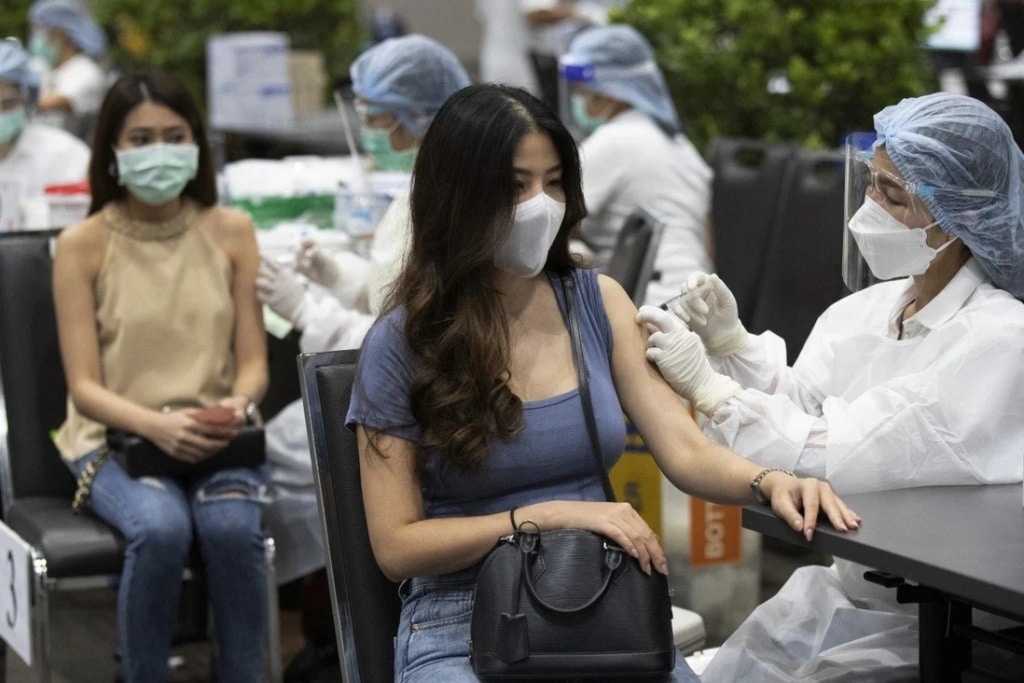News
Thailand Prepares for Chinese in 2023 as Russian Arrivals Increase

Thailand has seen a surge in Russian visitors, with monthly arrivals doubling in November and nearly seven times higher than in September, far outpacing increases in other countries in the run-up to peak travel season.
The country is experiencing a much-needed tourism boom, with 1.75 million visitors in November, more than quadrupling the number received for the entire year last year, when flights and foreign arrivals were limited due to the pandemic.
According to official data, the government removed the last vestige of its strict Covid-19 entry policies in July to revive the collapsed tourism sector, and since September, Russian arrivals have grown at a faster monthly rate than any other country, including those arising from low bases.
Before the pandemic, Russia was Thailand’s seventh-largest tourism market, with 1.48 million visitors in 2019, but every month in November, it was third behind Malaysia and India, with 108,985 arrivals, up from 44,314 in October and 15,900 in September.
In comparison, Malaysian arrivals fell steadily from 332,493 in September to 258,873 in November, while Indian visitors increased each month incrementally from 116,386 in September to 145,628 in November.

Russian visitors in November accounted for roughly 60% of those who visited in the same month in 2019.
“This year has seen a return of the Russian market, particularly following the Ukraine conflict,” said Stuart Reading, deputy CEO of Laguna Resorts and Hotels.
He credited the strengthening of the rouble against the baht and his chain’s hiring of some Russian-speaking personnel.
This year, the rouble has been one of the best-performing major currencies against the US dollar.
On average, Russian visitors stay for seven to ten nights, while “snowbirds” escaping the harsh winter back home can stay for up to three months.
According to Yuthasak Supasorn, governor of Thailand’s Tourism Authority, Russians make up about a quarter of the island’s visitors, helped by direct flights between Phuket and Bangkok.
“We’re seeing Russian families renting homes and staying from 16 days to a few months,” said Bhummikitti Ruktaengam, advisory chairman of Phuket’s Tourist Association.
“You’ll see Russian families strolling in the park with locals in the evening,” he said, adding that some were staying until March.
According to the TAT, total arrivals could exceed 11.5 million by year’s end, just over a quarter of the record of nearly 40 million in 2019, who spent approximately 1.91 trillion baht.

Thailand Prepares for Chinese Tourists
Meanwhile, the government is preparing to welcome back Chinese tourists after Beijing decided to ease travel restrictions earlier than expected.
On Wednesday, Transport Minister Saksayam Chidchob said he and Tourism and Sports Minister Phiphat Ratchakitprakarn had been invited to a meeting with the Public Health Ministry at Government House on January 5 to prepare for the return of Chinese tourists.
Mr. Saksayam also stated that the Ministry of Public Health is coordinating with the Chinese embassy to obtain information about China’s reopening to help prepare travel measures.
He expressed confidence in the Ministry of Public Health’s ability to handle the Covid-19 crisis.
Furthermore, he said that the return of Chinese tourists is expected to be gradual.
He said the Civil Aviation Authority of Thailand (CAAT) and the Aeronautical Radio of Thailand (Aerothai) are gathering information about the number of flights and tourists for the Transport Ministry, and the ministry has about a week to make plans.
Airlines are expected to file requests with Airports of Thailand (AoT) before the New Year holidays, and flights to Bangkok, Chiang Mai, and Phuket are expected to resume initially. Charter flights are also expected during Chinese New Year, according to him.

7-10 Million Chinese Tourists
He has directed airports to increase ground handling capacity to avoid unnecessary delays or inconvenience. The number of Chinese travelers using AoT-operated airports is expected to be around 7-10 million next year, compared to the pre-Covid figure of 20.5 million.
Mr. Saksayam paid a visit to Suvarnabhumi Airport on Wednesday afternoon, ahead of the New Year rush, and inquired about the airport’s readiness to return Chinese visitors.
Traisulee Taisaranakul, a deputy government spokeswoman, said the government is closely monitoring China’s reopening.
She stated that the Ministries of Foreign Affairs, Public Health, Transport, and Tourism and Sports would be informed of new developments as they become available.
“This is to ensure that Thailand is ready to welcome Chinese visitors,” she explained.
Following China’s reopening, people close to Thailand’s tourism and travel sector estimate that the number of international visitors in 2023 will be 25 million rather than the 20 million predicted.
Thailand’s Tourism Authority predicts 20 million visitors next year. Before Covid, Chinese tourists accounted for 30% of international arrivals or approximately 11 million in 2019.

Vaccinations Ahead of Tourist Surge
Meanwhile, Nanthakarn Suwanpidokkul, deputy director of the Government Pharmaceutical Organization (GPO), stated that the GPO had developed its antiviral drug, molnupiravir, to treat Covid-19.
She stated that the GPO has begun producing the drug, increasing the country’s supply of antiviral drugs and people’s access to affordable treatment. Molnupiravir has so far been obtained from outside the country, she added.
She stated that locally produced molnupiravir will be distributed to hospitals this week and that patients with prescriptions can purchase the drug at any GPO drug store.
Prime Minister Prayut Chan-o-cha has welcomed airlines’ decision to reduce airfares by 20% beginning in January, following the government’s decision to reduce the excise tax on jet fuel to 20 satangs per liter to boost tourism.
Anucha Burapachaisri, a government spokesman, said Gen Prayut was pleased to learn of the Thai Airline Association’s decision and thanked them for assisting the government in stimulating travel and local consumption and reviving the economy. In January, all seven airlines will run promotions with airfares reduced by up to 20%.
In preparation for the return of Chinese tourists, the Tourism and Sports Ministry hopes to provide Covid-19 booster shots to tourists and Thai tourism workers.
Tourism and Sports Minister Phiphat Ratchakitprakarn said the investment would be worthwhile because vaccine prices have dropped to a few hundred baht per shot.
Mr. Phiphat stated that if the average tourist spent 40,000 baht and 7% VAT was collected, the value would exceed the vaccine prices.
“It will help Thailand’s image because we are ranked among the top nations for healthcare security,” he said.
Mr. Phiphat stated that the Tourism and Sports Ministry would investigate the feasibility of this idea in collaboration with the Tourism Authority of Thailand and the Public Health Ministry.
He said that if the government approves the scheme, funds should be allocated to the Public Health Ministry to purchase vaccines.

News
Trudeau’s Gun Grab Could Cost Taxpayers a Whopping $7 Billion

A recent report indicates that since Trudeau’s announcement of his gun buyback program four years ago, almost none of the banned firearms have been surrendered.
The federal government plans to purchase 2,063 firearm models from retailers following the enactment of Bill C-21, which amends various Acts and introduces certain consequential changes related to firearms. It was granted royal assent on December 15 of last year.
This ban immediately criminalized the actions of federally-licensed firearms owners regarding the purchase, sale, transportation, importation, exportation, or use of hundreds of thousands of rifles and shotguns that were previously legal.
The gun ban focused on what it termed ‘assault-style weapons,’ which are, in reality, traditional semi-automatic rifles and shotguns that have enjoyed popularity among hunters and sport shooters for over a century.
In May 2020, the federal government enacted an Order-in-Council that prohibited 1,500 types of “assault-style” firearms and outlined specific components of the newly banned firearms. Property owners must adhere to the law by October 2023.
Trudeau’s Buyback Hasn’t Happened
“In the announcement regarding the ban, the prime minister stated that the government would seize the prohibited firearms, assuring that their lawful owners would be ‘grandfathered’ or compensated fairly.” “That hasn’t happened,” criminologist Gary Mauser told Rebel News.
Mauser projected expenses ranging from $2.6 billion to $6.7 billion. The figure reflects the compensation costs amounting to $756 million, as outlined by the Parliamentary Budget Office (PBO).
“The projected expenses for gathering the illegal firearms are estimated to range from $1.6 billion to $7 billion.” “This range estimate increases to between $2.647 billion and $7 billion when compensation costs to owners are factored in,” Mauser stated.
Figures requested by Conservative MP Shannon Stubbs concerning firearms prohibited due to the May 1, 2020 Order In Council reveal that $72 million has been allocated to the firearm “buyback” program, yet not a single firearm has been confiscated to date.
In a recent revelation, Public Safety Canada disclosed that the federal government allocated a staggering $41,094,556, as prompted by an order paper question from Conservative Senator Don Plett last September, yet yielded no tangible outcomes.
An internal memo from late 2019 revealed that the Liberals projected their politically motivated harassment would incur a cost of $1.8 billion.
Enforcement efforts Questioned
By December 2023, estimates from TheGunBlog.ca indicate that the Liberals and RCMP had incurred or were responsible for approximately $30 million in personnel expenses related to the enforcement efforts. The union representing the police service previously stated that the effort to confiscate firearms is a “misdirected effort” aimed at ensuring public safety.
“This action diverts crucial personnel, resources, and funding from tackling the more pressing and escalating issue of criminal use of illegal firearms,” stated the National Police Federation (NPF).
The Canadian Sporting Arms & Ammunition Association (CSAAA), representing firearms retailers, has stated it will have “zero involvement” in the confiscation of these firearms. Even Canada Post held back from providing assistance due to safety concerns.
The consultant previously assessed that retailers are sitting on almost $1 billion worth of inventory that cannot be sold or returned to suppliers because of the Order-In-Council.
“Despite the ongoing confusion surrounding the ban, after four years, we ought to be able to address one crucial question.” Has the prohibition enhanced safety for Canadians? Mauser asks.
Illegally Obtained Firearms are the Problem
Statistics Canada reports a 10% increase in firearm-related violent crime between 2020 and 2022, rising from 12,614 incidents to 13,937 incidents. In that timeframe, the incidence of firearm-related violent crime increased from 33.7 incidents per 100,000 population in 2021 to 36.7 incidents the subsequent year.
“This marks the highest rate documented since the collection of comparable data began in 2009,” the criminologist explains.
Supplementary DataData indicates that firearm homicides have risen since 2020. “The issue lies not with lawfully-held firearms,” Mauser stated.
Firearms that have been banned under the Order-in-Council continue to be securely stored in the safes of their lawful owners. The individuals underwent a thorough vetting process by the RCMP and are subject to nightly monitoring to ensure there are no infractions that could pose a risk to public safety.
“The firearms involved in homicides were seldom legally owned weapons wielded by their rightful owners,” Mauser continues. The number of offenses linked to organized crime has surged from 4,810 in 2016 to a staggering 13,056 in 2020.
“If those in power … aim to diminish crime and enhance public safety, they ought to implement strategies that effectively focus on offenders and utilize our limited tax resources judiciously to reach these objectives,” he stated.
Related News:
Millennials in Canada Have Turned their Backs on Justin Trudeau
Millennials in Canada Have Turned their Backs on Justin Trudeau
News
Google’s Search Dominance Is Unwinding, But Still Accounting 48% Search Revenue

Google is so closely associated with its key product that its name is a verb that signifies “search.” However, Google’s dominance in that sector is dwindling.
According to eMarketer, Google will lose control of the US search industry for the first time in decades next year.
Google will remain the dominant search player, accounting for 48% of American search advertising revenue. And, remarkably, Google is still increasing its sales in the field, despite being the dominating player in search since the early days of the George W. Bush administration. However, Amazon is growing at a quicker rate.
Google’s Search Dominance Is Unwinding
Amazon will hold over a quarter of US search ad dollars next year, rising to 27% by 2026, while Google will fall even more, according to eMarketer.
The Wall Street Journal was first to report on the forecast.
Lest you think you’ll have to switch to Bing or Yahoo, this isn’t the end of Google or anything really near.
Google is the fourth-most valued public firm in the world. Its market worth is $2.1 trillion, trailing just Apple, Microsoft, and the AI chip darling Nvidia. It also maintains its dominance in other industries, such as display advertisements, where it dominates alongside Facebook’s parent firm Meta, and video ads on YouTube.
To put those “other” firms in context, each is worth more than Delta Air Lines’ total market value. So, yeah, Google is not going anywhere.
Nonetheless, Google faces numerous dangers to its operations, particularly from antitrust regulators.
On Monday, a federal judge in San Francisco ruled that Google must open up its Google Play Store to competitors, dealing a significant blow to the firm in its long-running battle with Fortnite creator Epic Games. Google announced that it would appeal the verdict.
In August, a federal judge ruled that Google has an illegal monopoly on search. That verdict could lead to the dissolution of the company’s search operation. Another antitrust lawsuit filed last month accuses Google of abusing its dominance in the online advertising business.
Meanwhile, European regulators have compelled Google to follow tough new standards, which have resulted in multiple $1 billion-plus fines.

Pixa Bay
Google’s Search Dominance Is Unwinding
On top of that, the marketplace is becoming more difficult on its own.
TikTok, the fastest-growing social network, is expanding into the search market. And Amazon has accomplished something few other digital titans have done to date: it has established a habit.
When you want to buy anything, you usually go to Amazon, not Google. Amazon then buys adverts to push companies’ products to the top of your search results, increasing sales and earning Amazon a greater portion of the revenue. According to eMarketer, it is expected to generate $27.8 billion in search revenue in the United States next year, trailing only Google’s $62.9 billion total.
And then there’s AI, the technology that (supposedly) will change everything.
Why search in stilted language for “kendall jenner why bad bunny breakup” or “police moving violation driver rights no stop sign” when you can just ask OpenAI’s ChatGPT, “What’s going on with Kendall Jenner and Bad Bunny?” in “I need help fighting a moving violation involving a stop sign that wasn’t visible.” Google is working on exactly this technology with its Gemini product, but its success is far from guaranteed, especially with Apple collaborating with OpenAI and other businesses rapidly joining the market.
A Google spokeswoman referred to a blog post from last week in which the company unveiled ads in its AI overviews (the AI-generated text that appears at the top of search results). It’s Google’s way of expressing its ability to profit on a changing marketplace while retaining its business, even as its consumers steadily transition to ask-and-answer AI and away from search.

Google has long used a single catchphrase to defend itself against opponents who claim it is a monopoly abusing its power: competition is only a click away. Until recently, that seemed comically obtuse. Really? We are going to switch to Bing? Or Duck Duck Go? Give me a break.
But today, it feels more like reality.
Google is in no danger of disappearing. However, every highly dominating company faces some type of reckoning over time. GE, a Dow mainstay for more than a century, was broken up last year and is now a shell of its previous dominance. Sears declared bankruptcy in 2022 and is virtually out of business. US Steel, long the foundation of American manufacturing, is attempting to sell itself to a Japanese corporation.
SOURCE | CNN
News
The Supreme Court Turns Down Biden’s Government Appeal in a Texas Emergency Abortion Matter.

(VOR News) – A ruling that prohibits emergency abortions that contravene the Supreme Court law in the state of Texas, which has one of the most stringent abortion restrictions in the country, has been upheld by the Supreme Court of the United States. The United States Supreme Court upheld this decision.
The justices did not provide any specifics regarding the underlying reasons for their decision to uphold an order from a lower court that declared hospitals cannot be legally obligated to administer abortions if doing so would violate the law in the state of Texas.
Institutions are not required to perform abortions, as stipulated in the decree. The common populace did not investigate any opposing viewpoints. The decision was made just weeks before a presidential election that brought abortion to the forefront of the political agenda.
This decision follows the 2022 Supreme Court ruling that ended abortion nationwide.
In response to a request from the administration of Vice President Joe Biden to overturn the lower court’s decision, the justices expressed their disapproval.
The government contends that hospitals are obligated to perform abortions in compliance with federal legislation when the health or life of an expectant patient is in an exceedingly precarious condition.
This is the case in regions where the procedure is prohibited. The difficulty hospitals in Texas and other states are experiencing in determining whether or not routine care could be in violation of stringent state laws that prohibit abortion has resulted in an increase in the number of complaints concerning pregnant women who are experiencing medical distress being turned away from emergency rooms.
The administration cited the Supreme Court’s ruling in a case that bore a striking resemblance to the one that was presented to it in Idaho at the beginning of the year. The justices took a limited decision in that case to allow the continuation of emergency abortions without interruption while a lawsuit was still being heard.
In contrast, Texas has been a vocal proponent of the injunction’s continued enforcement. Texas has argued that its circumstances are distinct from those of Idaho, as the state does have an exemption for situations that pose a significant hazard to the health of an expectant patient.
According to the state, the discrepancy is the result of this exemption. The state of Idaho had a provision that safeguarded a woman’s life when the issue was first broached; however, it did not include protection for her health.
Certified medical practitioners are not obligated to wait until a woman’s life is in imminent peril before they are legally permitted to perform an abortion, as determined by the state supreme court.
The state of Texas highlighted this to the Supreme Court.
Nevertheless, medical professionals have criticized the Texas statute as being perilously ambiguous, and a medical board has declined to provide a list of all the disorders that are eligible for an exception. Furthermore, the statute has been criticized for its hazardous ambiguity.
For an extended period, termination of pregnancies has been a standard procedure in medical treatment for individuals who have been experiencing significant issues. It is implemented in this manner to prevent catastrophic outcomes, such as sepsis, organ failure, and other severe scenarios.
Nevertheless, medical professionals and hospitals in Texas and other states with strict abortion laws have noted that it is uncertain whether or not these terminations could be in violation of abortion prohibitions that include the possibility of a prison sentence. This is the case in regions where abortion prohibitions are exceedingly restrictive.
Following the Supreme Court’s decision to overturn Roe v. Wade, which resulted in restrictions on the rights of women to have abortions in several Republican-ruled states, the Texas case was revisited in 2022.
As per the orders that were disclosed by the administration of Vice President Joe Biden, hospitals are still required to provide abortions in cases that are classified as dire emergency.
As stipulated in a piece of health care legislation, the majority of hospitals are obligated to provide medical assistance to patients who are experiencing medical distress. This is in accordance with the law.
The state of Texas maintained that hospitals should not be obligated to provide abortions throughout the litigation, as doing so would violate the state’s constitutional prohibition on abortions. In its January judgment, the 5th United States Circuit Court of Appeals concurred with the state and acknowledged that the administration had exceeded its authority.
SOURCE: AP
SEE ALSO:
Could Last-Minute Surprises Derail Kamala Harris’ Campaign? “Nostradamus” Explains the US Poll.
-

 News3 years ago
News3 years agoLet’s Know About Ultra High Net Worth Individual
-
Entertainment2 years ago
Mabelle Prior: The Voice of Hope, Resilience, and Diversity Inspiring Generations
-

 Health4 years ago
Health4 years agoHow Much Ivermectin Should You Take?
-

 Tech2 years ago
Tech2 years agoTop Forex Brokers of 2023: Reviews and Analysis for Successful Trading
-

 Lifestyles3 years ago
Lifestyles3 years agoAries Soulmate Signs
-

 Movies2 years ago
Movies2 years agoWhat Should I Do If Disney Plus Keeps Logging Me Out of TV?
-

 Health3 years ago
Health3 years agoCan I Buy Ivermectin Without A Prescription in the USA?
-

 Learning3 years ago
Learning3 years agoVirtual Numbers: What Are They For?
